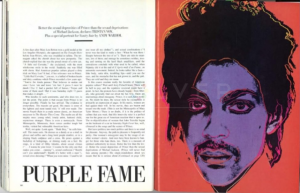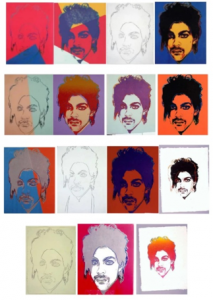 As of March 28, 2022, the Supreme Court of the United States granted certiorari to render a final decision that may affect copyright law in more ways than one. The case of Andy Warhol’s (“Warhol”) popular silkscreen prints and pencil illustrations of pop superstar, Prince, is on the Supreme Court’s docket. The Court will be deciding “whether a work of art is ‘transformative’ when it conveys a different meaning or message from its source material or whether a court is forbidden from considering the meaning of the accused work where it ‘recognizably deriv[es] from’ its source material.”
As of March 28, 2022, the Supreme Court of the United States granted certiorari to render a final decision that may affect copyright law in more ways than one. The case of Andy Warhol’s (“Warhol”) popular silkscreen prints and pencil illustrations of pop superstar, Prince, is on the Supreme Court’s docket. The Court will be deciding “whether a work of art is ‘transformative’ when it conveys a different meaning or message from its source material or whether a court is forbidden from considering the meaning of the accused work where it ‘recognizably deriv[es] from’ its source material.”
In 1981, photographer Lynn Goldsmith (“Goldsmith”) took various photographs of Prince as part of an assignment she was commissioned for by Vanity Fair. In 1984, Goldsmith, through her agency, Lynn Goldsmith Ltd., licensed one of the photographs she took of Prince to Vanity Fair to be used as an “artist reference.” The artist who would use Goldsmith’s photograph as a reference was Warhol. Warhol was commissioned by Vanity Fair to create an image of Prince to be published in one of their issues. However, Warhol did not only create the image he was commissioned for by Vanity Fair, he created an additional fifteen works, known collectively as the “Prince Series.” In 2016, upon Prince’s death, Goldsmith first became aware of the Prince Series. Soon after, Goldsmith notified the Andy Warhol Foundation (“AWF”), the successor of Warhol’s copyright in the Prince Series, of the alleged copyright violation of her photograph. AWF subsequently filed suit against Goldsmith in a declaratory action alleging that the Prince Series was a non-infringing work or that, in the alternative, it was at least considered fair use.
The United States District Court for the Southern District of New York found for AWF as they considered the images to be fair use upon evaluating the four statutory fair use factors under the Copyright Act. These factors are as follows: (1) the purpose and character of the use, including whether such use is of a commercial nature or is for nonprofit educational purposes; (2) the nature of the copyrighted work; (3) the amount and substantiality of the portion used in relation to the copyrighted work as a whole; and (4) the effect of the use upon the potential market for or value of the copyrighted work. Conversely, on appeal, the Second Circuit reversed the former ruling as it did not find Warhol’s work to be fair use. The Second Circuit held that Warhol’s work was not “transformative” because it “retaine[d] the essential elements of the Goldsmith Photograph without significantly adding to or altering those elements.” Moreover, the Second Circuit found that “whether a work is transformative cannot turn merely on the stated or perceived intent of the artist or the meaning or impression that a critic – or for that matter, a judge – draws from the work.”
Ultimately, an eye must be kept on the Supreme Court’s final holding on the matter as this case is set to be heard during the Supreme Court’s October 2022 term. This decision will implicate the AWF and possibly future cases as Warhol generally based his silkscreen prints off photographs. Additionally, this decision will be a significant one for those that draw inspiration from pre-existing works, delineating how much of their work they will need to alter to not have a copyright infringement lawsuit on their hands.



 As of March 28, 2022, the Supreme Court of the United States granted certiorari to render a final decision that may affect copyright law in more ways than one. The case of Andy Warhol’s (“Warhol”) popular silkscreen prints and pencil illustrations of pop superstar, Prince, is on the Supreme Court’s docket. The Court will be
As of March 28, 2022, the Supreme Court of the United States granted certiorari to render a final decision that may affect copyright law in more ways than one. The case of Andy Warhol’s (“Warhol”) popular silkscreen prints and pencil illustrations of pop superstar, Prince, is on the Supreme Court’s docket. The Court will be 